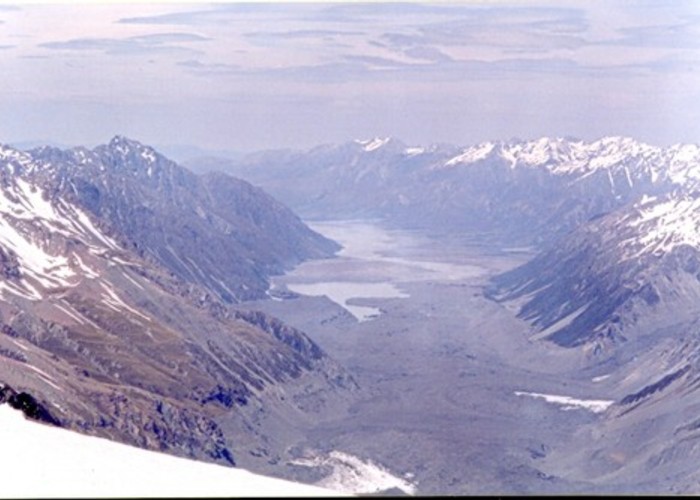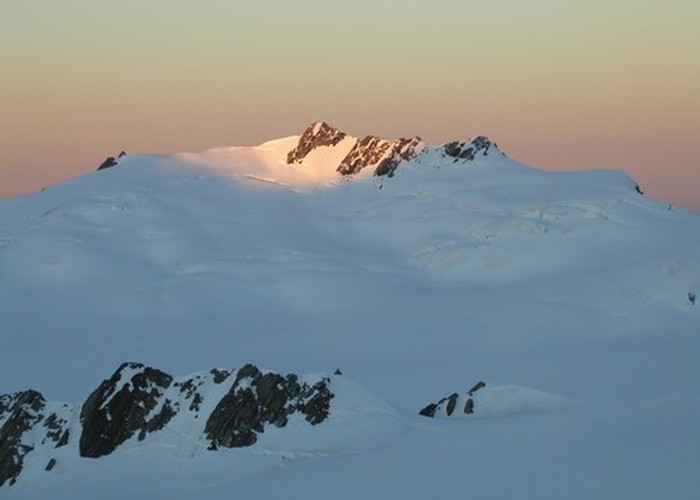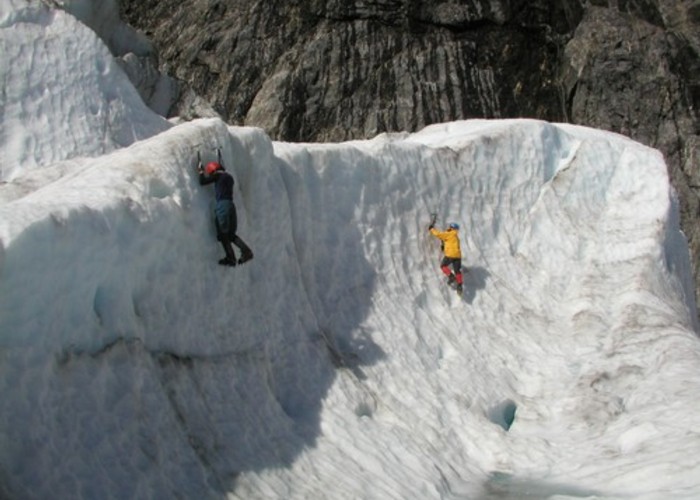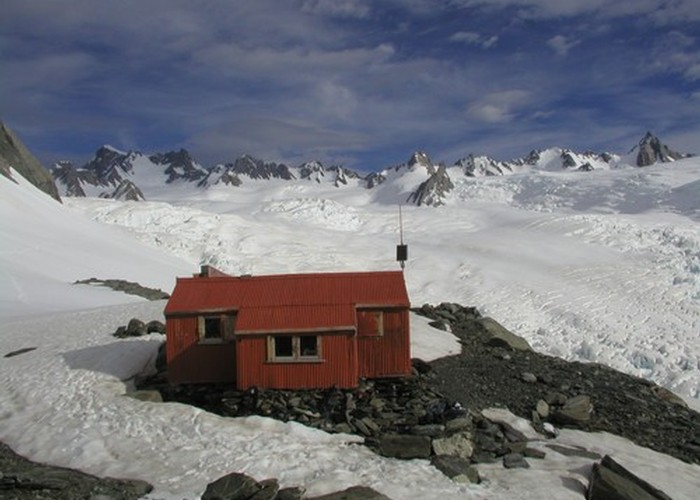We were preparing to move to Centennial hut. Some people nearby were digging in for the snow cave experience. Tracks from the previous day could be seen below stepping out across the neve toward West Hoe Pass. Two rope teams of two was to provide us with a relatively safe means of travel.

Choppers were buzzing the lower glacier taking advantage of the glorious weather to give the tourists the glacier experience. Even in summer good weather windows can be short and every opportunity is seized to generate some income.
We'd saved two days on foot by getting a chopper straight into Pioneer hut. There was no guarantee as to how long the high pressure system would last, although we had several days supply of food and access to hut radios for up to date information on weather and air traffic.
On a previous visit by ski plane from Mt.Cook village with two friends to spend a few days practising alpine skills there had been the frustration of not knowing the route out by foot and being somewhat dependant on air transport. We had flown out by chopper on that occasion to avoid being hut bound for a few days with the arrival of bad weather. Since then, i had travelled up the glacier to a heavily crevassed area above the trough beside Chancellor dome and there remained only a short section to cover to Pioneer hut.
Months of preparation had led to this moment and i felt a substantial burden knowing Alistair and Craig had never done any glacier travel and Kathryn had only visited the once during that trip to the point near to Chancellor dome. Getting them fitted and familiar with the practical use of the tools on the terminal ends of Fox and Franz Josef and hours of roping up and constructing pulley systems for crevasse rescue was surprisingly well received. It was peace of mind for me to have them taking it all so seriously. It could be me relying on them in an emergency.
All the practice helps reinforce my own knowledge learnt largely from participating in a TMC with Alpine Guides at Mt.Cook. It simply isn't enough to do a course. The knowledge passed on in ten days is no substitute for years of practice during which you absorb many hints and alternate systems. The skills need to be second nature. Due to changes in conditions every mountain experience needs to be treated like its a different mountain.

Most of the existing hut occupants weren't around as they had taken an alpine start to maximise their chance to bag some peaks on the Main divide. Pioneer hut is a popular start for attempts on Lendenfeld and Mt.Tasman as well as many lesser peaks closer to hand. Few people were there to witness our departure as we zig-zagged down a steep slope for a hundred metres below the hut. Starting across the Explorer glacier the volume of snow kept any crevasses well hidden as i led over reasonably flat terrain for a kilometre or so. A gradual incline over a few hundred metres was followed by a 45º ascent to the 2500m West Hoe Pass. The tracks we followed moved right to avoid some icefall from a bergschrund directly below the pass. Higher up they traversed above the icefall before easier slopes led into the pass. We enjoyed a break taking photos. One wonders how many times they'll get to such a location in idyllic conditions.
Careful study in all directions revealed no signs of life. It was possible to imagine oneself in one of the remotest locations on earth. There was not a breath of wind and the heat generated from carrying a heavy load and from being totally covered due to the solar reflection was stifling. A brief time exposed to the sun and snow at that altitude would ensure considerable sunburn. I stayed totally covered in preference to applying sunscreen lotions in order to avoid having the stuff on my fingers and subsequently in my eyes.
The descent from the pass and the route across the Davis snowfield was very straightforward and within 3 kilometres and probably an hour and a half we were near to Centennial hut. A climb up simple snowslopes to the ridge extending NW from Mt.Jervois was the end of our days glacier travel as it was midday and a good time to retire from the sun and the sugary nature of the snow.
We awoke to more fine weather and good snow conditions so it was ideal for a longer days travel to Almer Hut. Situated about 700m lower on Franz Josef glacier, it meant we'd have close to 8km of travel with what appeared to be heavily crevassed terrain below the Giekie snowfield.

Our roping up for the glacier uses the Kiwi coil. Highly regarded worldwide as an effectively simple method, it can be incorporated with very little equipment to do most of what is required on the glacier. Unlike in Europe where very well appointed huts in close proximity to one another, NZ glacier travel often means carrying more gear in case you're caught out between huts. Minimising the climbing gear can be of great assistance. Crevasse falls can eat up time,especially when they involve setting anchors, transferring the load and escaping the system to employ a 'Z' pulley or ab-seil to assist an injured partner. In addition to sudden changes in weather at NZ latitudes, several falls in a day could cost hours and result in very little ground covered.
Once roped up we embarked in an easterly direction to descend to the Chamberlain snowfield. We then turned NE to skirt above a crevassed area when we heard a thunk and a swish. i suppose it was inevitable. We all turned to see a snowstake picking up speed downhill until it disappeared into a crevasse. It was a stark reminder of the need to secure all items. It wasn't enough to place the stake behind the compression straps of the pack. Like so many items it is practical to consider a small lanyard for added security. There was a lot of thought having been given to minimising the load for the trip so it should have given Craig something to think about should he be needing to improvise in an emergency.
We continued on to cross the ridge extending out from Mt.Rudolf. Once on the other side we were out of sight from Centennial hut until we turned NW adjacent to the Lindon ridge and under Matenga Pk. From there a descent of 200m over a kilometre or so brought us to a gap in the ridge before Mackay Rocks. It allowed us to pass through to the northern side and use some steep snow bridges with depressions all around to gain access to the Giekie snowfield.

